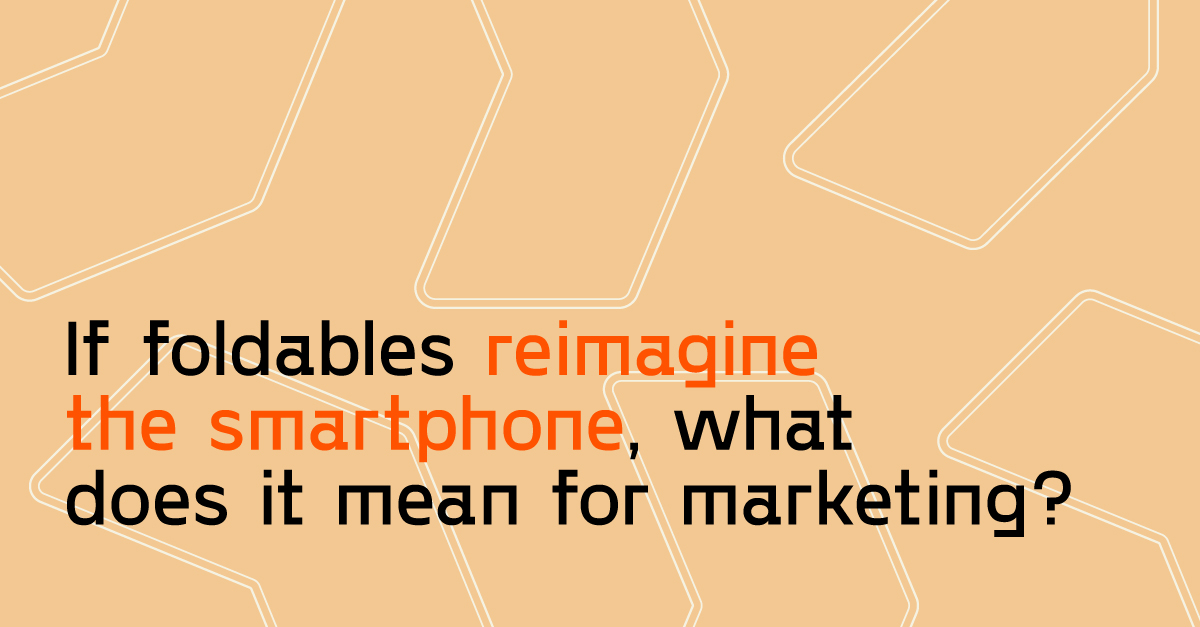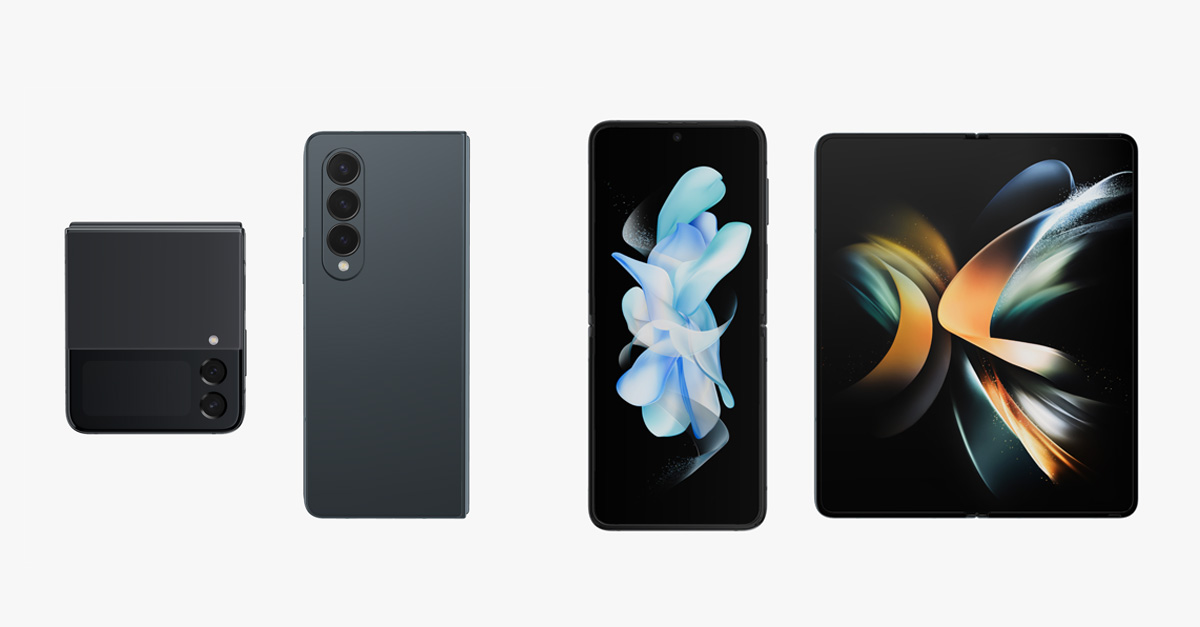As marketers, it’s crucial to understand how people interact with your content. These days it should be no surprise that most content is read, watched, and listened to on smartphones. Cell phone hardware is impressive already, but it’s going to get better (and better).
The marketing content you create needs to evolve to match these developments. Mobile-first should be seen as a given. But it’s worth also starting to think creatively about adapting your content strategy to unlock the potential of the next generation of smartphones. With developments in processing power, connectivity, audio and video technology, AI, and foldable screens just around the corner, it’s time to think about what comes next.
A campaign built around a gated eBook in PDF format may be ok now. But it will quickly seem dated if the competition is publishing immersive AR experiences built specifically to take advantage of foldable screens. Let’s explore how these changes will affect marketers and why mobile marketing is important.
Why mobile marketing is important
You probably don’t need to see a bunch of stats to illustrate the extent of smartphone domination. But here goes:
- 6.92 billion people or 86.29% of the world have smartphones
- If you focus on 16-64 year-olds it’s 96.4%
- The average smartphone user – that's you – checks their phone 63 time a day
- In the US, the average person spends over 5 hours on their phone each day
- There are 255 billion app downloads every year
- More than half (58%) of multi-device customer journeys are completed on mobile
Yet the mobile-first philosophy is rarely put fully into practice by B2B technology companies. But there’s no longer an excuse. You need to be on top of how mobile marketing works. The online buyer journey has shifted from desktop to mobile – more searches than ever take place on phones. What’s more, lines between B2B and B2C continue to blur. As Stephen Reilly, Head of Content at Fifty Five and Five, likes to say:
People are still people when they’re at work.
Tech companies shouldn't simply be optimising for mobile, they should be creating marketing campaigns directly for it.
What’s next? Here are the hard facts
With the success of ChatGPT, the world is entering a new era for AI. It remains to be seen how this will transform mobile experiences. It’s safe to say we’ll see smarter AI integration, better voice search, and it’s likely that Google and Microsoft will continue to work on bringing the full AI experience into their mobile and desktop apps.
But what about hardware? There are numerous developments on the horizon. This includes the rise of foldable phones, bigger screens in general, faster connectivity, enhanced audio and video, and increasingly powerful processors. This could finally lead to the AR and VR revolution that’s been promised for a while.
Mobile experiences are becoming more immediate, more immersive, and more convenient for users. People will no doubt spend even more time on their phones (is that possible?), including interacting with the relevant companies at work and consuming b2b tech content in new ways. So, it's clear just how important mobile marketing is and will continue to be.
Take your mobile marketing to the next level. Get in touch!
3 technology hardware breakthroughs to look out for
Let’s look at three major developments on the way. And explore how these will affect marketers and content creators.
1. Into the fold
Foldable phones will make complex multitasking simple, opening up new avenues for marketers to grab the attention of smartphone users. It’s time to experiment with more interactive, versatile and dynamic content.
Imagine how this can improve your workflow. It’s essentially using two screens at one time. It's like having two desktop monitors with you everywhere you go. This allows you to have Outlook on one and Excel open on the other. Then, when you need more space or want to zoom in, you can extend what you are reading across both screens.
So, what might this mean for marketing?
- Fold for more info
Some have suggested the "fold" capability could become like "swipe". It will be built into UX and user journeys, with new types of CTA modified to cater for this need. CTA copy would change to “Fold to read in full screen” or “Fold to watch in 4K widescreen”.
- Does size matter?
Analysis shows when people use 'phablets' - a screen size above 5 inches - they tend to interact more with personalized, real-time content.
- The multiplex experience
Everyone knows that video has been hot property in the era of social networks, largely thanks to smartphones. With bigger, better screens, this will only increase in its ubiquity. And creative ways of using multiple screens for different video content could be revolutionary.
- AR and VR rises
We might see more dynamic content experiences with graphics that jump from one screen to the other. With a larger screen and the potential for multi-screen, there are far wider applications for AR. Perhaps half the screen is showing you an AR product demo, while the other is connected to a salesperson on a Teams call.
When the first foldable phones came out a few years ago, there were reports of the screens breaking and creasing in the middle. Now that these issues are ironed out, foldable devices are set to reimagine the smartphone – and potentially inbound content marketing along with it.
See our application in mobile and content marketing here.
2. Surrounded by sound
Surround sound isn't anything new. Surround sound headphones, on the other hand, are. These new headphones will create a more immersive audio experience for users and should accelerate the rise of audio formats in marketing.
Leaps in audio fidelity and convenience have already been made in recent years. People use their phones on the go – pretty much anywhere and while doing anything. Podcasts have never been more popular.
As these experiences become central to how people consume content but also take meetings and carry out work tasks, your business must optimise for audio. Whether that is voice search, something we have written about before, or for podcast content or audio content.
For instance, you could use an AI tool to take a blog post and generate an audio version. Yes, it might sound a bit robotic, but that technology has improved a lot recently. Or you could sit down and record a proper recording. Either way, creating audio versions of text is a great way to tailor content to how mobile users want to consume content. It can also be a fantastic way to improve accessibility on your site.
3. Improved connectivity and more powerful processors
5G has proven to be quite the controversy in its early days. From conspiracy theories to geopolitical power plays, this technology has not had an easy ride so far. Of course, 5G will be superseded by 6G in years to come. Nonetheless, it’s clear that faster connectivity speeds will drive new experiences on mobile. Say goodbye to slow downloads and buffering. With 5G, you can download multi-modal content in seconds.
- Bigger brain power (not literally)
More powerful processors will make your smartphone faster and more responsive than ever before. No more waiting for apps to load or scrolling through laggy screens.
- Green and sustainable
New processors will also be designed to be more energy-efficient. This means your smartphone will last longer on a single charge. Say goodbye to dead batteries and hello to a more convenient and reliable mobile experience.
- Better video
More powerful processors will make your smartphone's camera even better, with faster autofocus and better image processing. You'll be able to take stunning photos and videos like a pro.
- Bigger brain power (literally)
More powerful processors will enable your smartphone to perform advanced AI tasks, such as natural language processing and object recognition. This means your phone will be smarter and more intuitive, helping you get things done faster and easier.
Seamless streaming will result in even more responsive and immersive ways to consume content. 5G's low latency and fast speeds make interactive experiences much more viable. Whether that is high quality video, AR, VR, gaming or a mix of all of these.
Will Mark Zuckerburg’s dreams of the metaverse become reality? Should you start taking metaverse experiences seriously? We’ll have to wait and see.
And beyond that. What comes next?
If we speculate beyond these advancements, we quite quickly get to the point where the very concept of a phone as handheld or even wearable breaks down. Are you ready for a neural implant? Just imagine, your “phone” riding shotgun on your cerebral cortex. Maybe we should leave that for another time.
But whatever new thing comes next, it's crucial to rethink and reformulate your approach to content marketing. Understanding why mobile marketing is important and how changes in hardware affect this is only the first step.
Our advice is to focus on mobile-first, immersive experiences that leverage the power of video and location-based marketing. This way you can effectively engage your target audience through their phones and stay one step ahead of advances in smartphone technology.
We can help you stay ahead
Fifty Five and Five is a B2B technology marketing agency based in London, offering everything from paid, SEO, content, social media, design, and development. We can advise, plan, and work with you to better position your business for a mobile-first world.
To learn more about how mobile marketing works, check out our B2B content marketing and demand generation services.




